Digitalization is still being accelerated and invested everywhere – and agreeing on the business case for continued investments is evergreen on the executive agenda. The topic of advancing within the field of data has grown to become an increasingly important part of this agenda. Data-driven organizations are reshaping the way they gather, manage, synthesize and monetize data, and as investments in infrastructure, capabilities and operations grow, the challenges are the same for data. Investments in data have grown and continue to grow, but companies are falling behind on monetizing the value hereof.
With AI taking up more and more attention, investments in data and solid foundations to accelerate AI, are more present and crucial than ever. Data foundation is the shoulders that AI stands on – and most likely despite investing in data for years – more investments and focus will be needed in the years to come. However, internally in companies, discussions can often be difficult, and from Valtech’s experience, we see many stakeholders being challenged when bringing the rest of the company on board to either support or understand the investments in data as it is often something that occurs behind the scenes.
From our perspective, the problem is that the first mindset, data-driven approach and data to support personalization have become a sleeping pillow for many. As much as these overarching focus points can work, it has also led to companies forgetting the bigger purpose of investing heavily in data. As with any investment, this should only be done when an adequate return is expected. These discussions of investments in data often lack an understanding of how data ties to business outcomes, but that is essential for building long-term returns on data assets. So, how do we change this conversation, monetize the data investments and focus on how data is tied to more concrete and actual business outcomes?
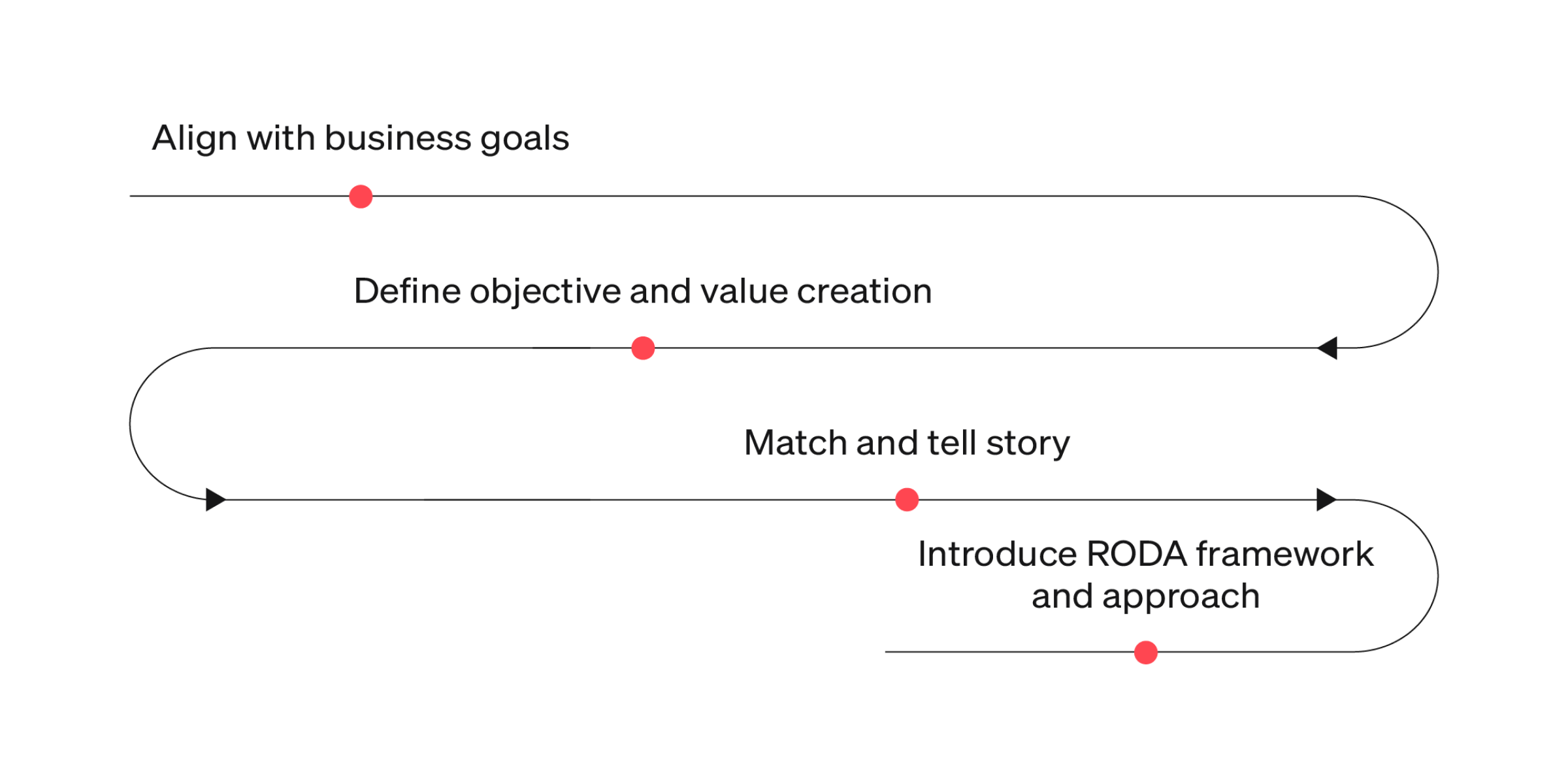
How to articulate the business case for data?
To articulate the business case for data, CTOs and CDOs must tell a story that resonates. Taking a strict business perspective on the return of data, focusing on how data initiatives contribute to the organization's overall strategic objectives and financial performance, but also elevating the culture along the way are places to start.
Align with Business Goals
Ensure that data initiatives are aligned with the company's strategic priorities and contribute to achieving key business objectives, such as revenue growth, cost reduction, market expansion, or customer satisfaction are low-hanging fruits to ensure consistency and direct relationship to the business’ strategy, goals and performance.
Define Objectives and value creation
Determine what you want to achieve with your data investments. Whether it's increased revenue, cost savings, improved operational efficiency, or better decision-making, it is crucial to the success of the data investment that a desired objective is established to create and measure the attached value of the data investments and that there is a feasible road to execute and deliver real value.
Further, the long-term impact of data investments on the organization's competitiveness, innovation capabilities, and market positioning should be evaluated as part of the process. This involves looking beyond short-term financial returns to consider the broader value that data-driven insights and capabilities can bring to the business over time.
Match and tell story
Attribute the outcomes or changes observed to the data investments made. This involves determining the extent to which the observed results can be directly linked to the data initiatives, and what other, non-predicted, factors have come to show.
Telling a story is one thing, but making it resonate with the receiver — whether that being C-level or the entire organization — the story components must be matched and attributed to relevant changes and outcomes.
Introduce RODA (Return on Data Assets) framework and approach
Provide a clear formula and framework in which data projects can be compared within and across companies. Taking inspiration from Junta Nakai, author of the article Return on Data Assets: A New Way for CFOs to Measure the Value of Data, we recommend introducing the financial ratio called return on data assets. The basic formula for RODA is in all simplicity income driven by data assets divided by the cost to create and maintain data assets.
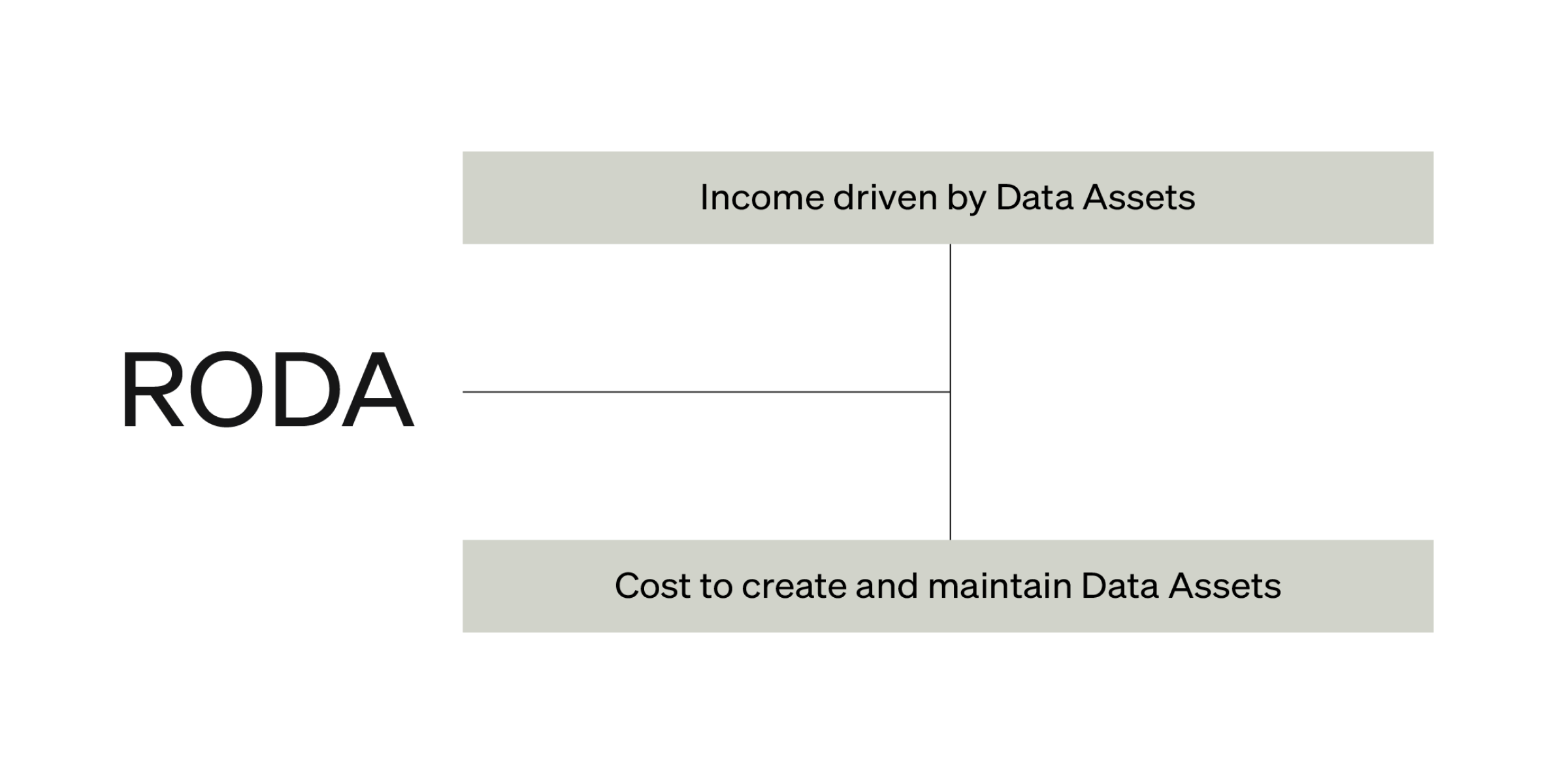
This basic formula quantifies a company’s ability to monetize the data they have cost-effectively. The principles of the formula require chief data officers (CDOs) to know the underlying numbers for the equation.
On the numerator side, CDOs must focus on use cases where data can be leveraged to drive business value. Data assets can be a dataset, a notebook, or even an Excel model. On the denominator side, CDOs must find the most cost-effective way to create (or acquire), maintain, and secure data assets; increase value from existing data assets; and decommission unproductive data assets.
At the micro level, the RODA framework helps CDOs, and lines of business prioritize projects. On the macro level, RODA helps CFOs allocate capital more efficiently and helps CTOs make the right technology decisions. Simply put, if RODA is higher than the cost of capital, then a project creates positive economic value. If it’s not, the project or initiative is not worth pursuing.
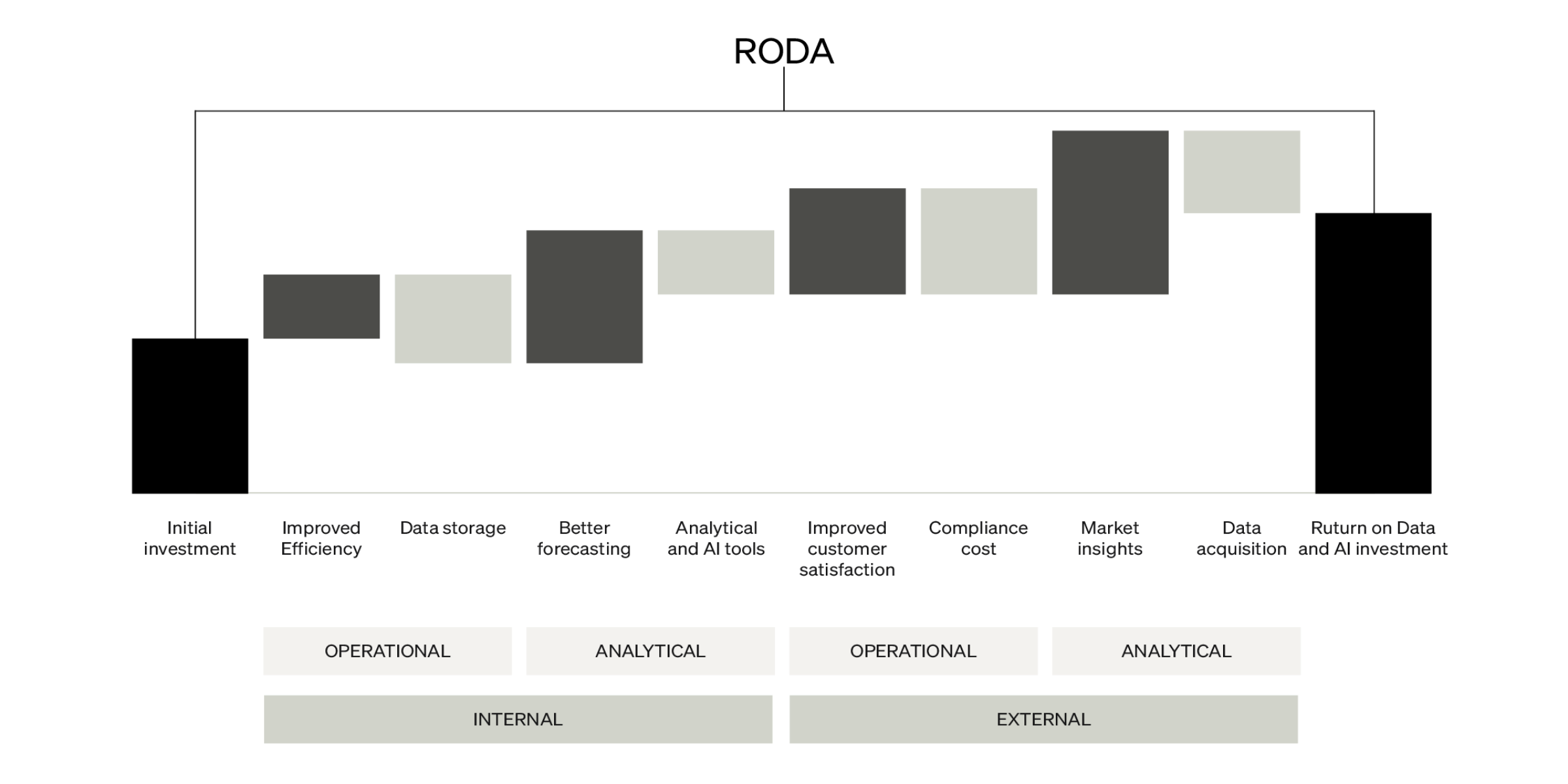
How to create momentum when executing data initiatives
The emerging need for businesses to quantify the value of their data assets resonates back to the momentum needing to be established. Due to the historical difficulties of quantifying the value of data, data is often not included in critical assets for companies and their balance sheets despite its importance.
To create momentum with data, the concept, as presented above with RODA, measures more concretely the income generated from data assets against the costs of creating and maintaining the assets. However, the cost is often what’s in focus as data management, storage, and foundations can be a costly affair. But if we can shift focus to show the value of executing with data, RODA can help prioritize initiatives and high-value use cases for data based on their potential return.
From a strategic benefit point-of-view, and as mentioned earlier, RODA can help prioritize on a more micro level. At the macro level, it assists the C-level in focusing on data, on creating momentum with the data initiatives by ensuring capital allocation and investments provide the business value in return.
For data investments to be effective, companies must cultivate a culture that values and utilizes data across all levels by enabling data as a must and integral measure in decision-making processes and strategies to drive revenue and enhance profitability.
Valtech recommends three concrete takeaways to create momentum when establishing and executing data initiatives:
Implement Return on Data Assets (RODA): Use the Return on Data Assets (RODA) metric to measure the value generated from data assets relative to the costs of maintaining them. This can help prioritize data projects that offer the highest returns and justify investments in data infrastructure and analytics.
Recommended Action: Develop a framework to calculate RODA for all data initiatives. Regularly track and report this metric to ensure data investments align with business objectives and demonstrate tangible value.
Foster a Data-Driven Led Culture: Cultivate a company-wide culture that values data by promoting data and encouraging data-driven decision-making. It helps ensure that employees at all levels understand the importance of data and are equipped to use it effectively by educating, nudging and showing the beneficial sides of how data can support performance and returns in work. A data-driven and led culture will involve the end-users —also known as data customers —– by involving and understanding their needs to obtain the right insights but also how their projects and digital products can become more valuable through better data.
Recommended Action: Implement training programs and workshops to improve data literacy. It helps promote success stories where data has led to significant business outcomes to highlight the benefits and encourage wider adoption of data practices across the company and provides a rings-in-the-water effect over time.
Establishing Robust Data Governance to better execute AI and its potential: Before accelerating data practices with AI, part of building momentum is to ensure a strong data governance policy and system is established and implemented across the company. This ensures data quality, security, and compliance, which is crucial for further success using data. What we see is companies focusing on good data governance, which can help maximize the value extracted from data and mitigate risks associated with data management, for example when working towards artificial intelligence. In essence, these should be seen as essential hygiene factors that need to be in place before you can start to really discuss the actual value creation and execute properly on use cases. Establishing robust data governance will help unlock the opportunity for numerous use cases.
Recommended Action: Valtech holds experience with developing and enforcing data governance frameworks that define data ownership, standardize data practices, and ensure data integrity across companies. We recommend regularly auditing and updating these frameworks to keep up with the evolving business needs and regulatory requirements to also be sure to show value back to the business.
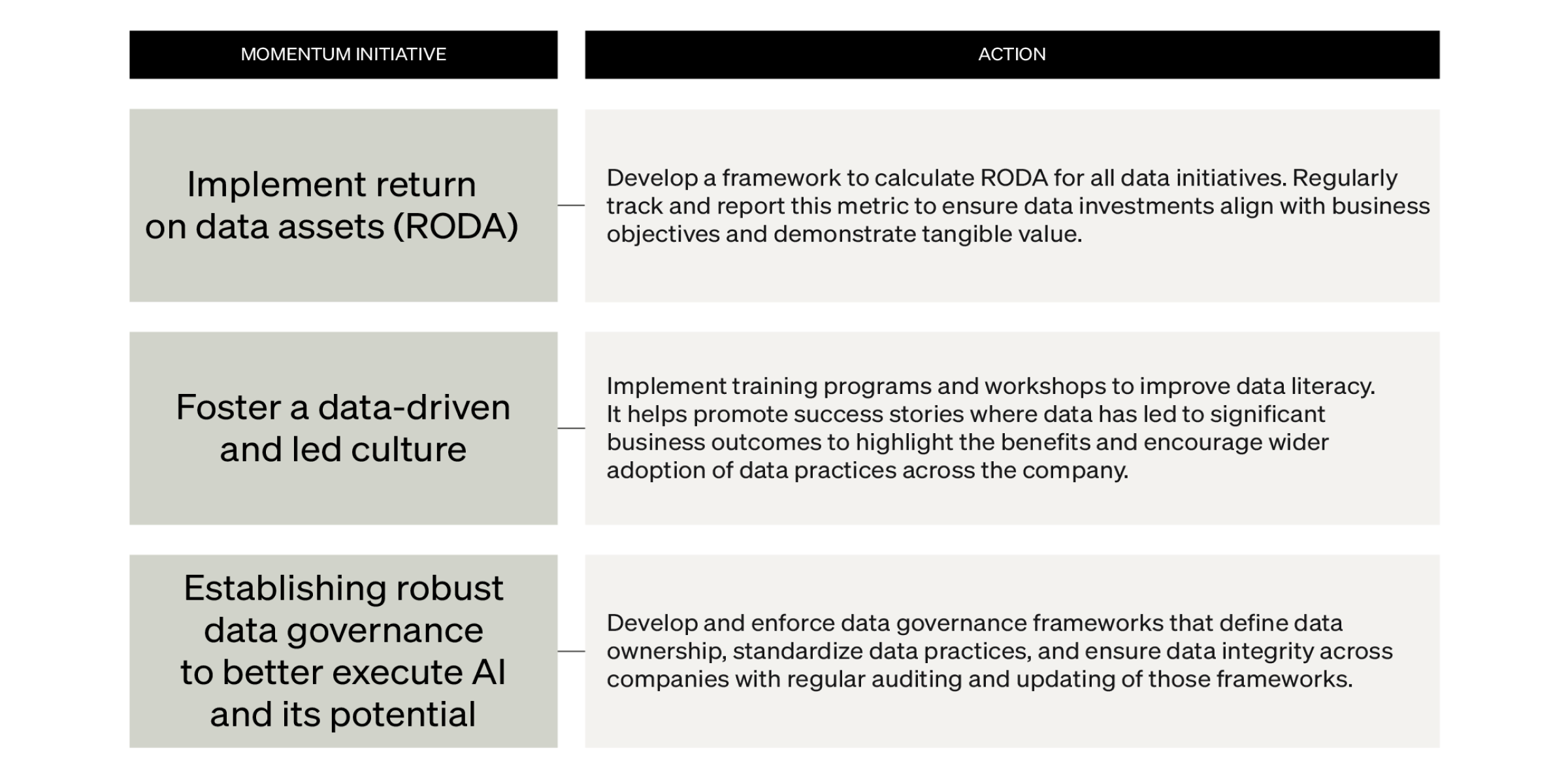
How to approach the acceleration of your data practice with AI?
Having implemented RODA, focused on establishing momentum and robust foundations, companies are building solid foundations for their data initiatives which ensures that data is leveraged effectively to drive business value.
Driving value out of data to show how return on data assets can become more valuable to the business and maximize the investments, AI can play a part as an additional lever. Accelerating data practices with AI to support and showcase the return on data investments can be done in multiple ways, but to keep the RODA in mind, Valtech recommends the following items when accelerating data practices with AI:
-
Map out current processes where data plays a crucial role today within the business. It is essential to gain visibility into data and enable employees to use it to drive revenues and profits. Therefore, understanding: Where is data a key component? Where is most effort being made today? What are the current processes of data handling? How can we optimize or improve the process today?
-
Identify underutilized areas of data and potential AI usage. Know which data is being used or not used today. Is there any potential to identify use cases that the business isn’t doing or looking at today because they have required too much effort? It is the sweet spot of finding the right balance between what is feasible and not too costly but can provide a return vs what is done today.
-
Map out potential AI use cases by opportunity to drive success. Mapping out use cases to further understand potential and return on investment can help prioritize between investment, IT and business value. However, keeping feasibility (both technical and organization) as well as readiness (internal and external) in mind is essential when conducting business cases on AI.
AI can help drive additional value out of data, which then adds to the existing focus of showing the return of a data asset. In essence, by conducting the business case of AI and its use cases and potential solutions, companies can maximize RODA to eventually help accelerate value.
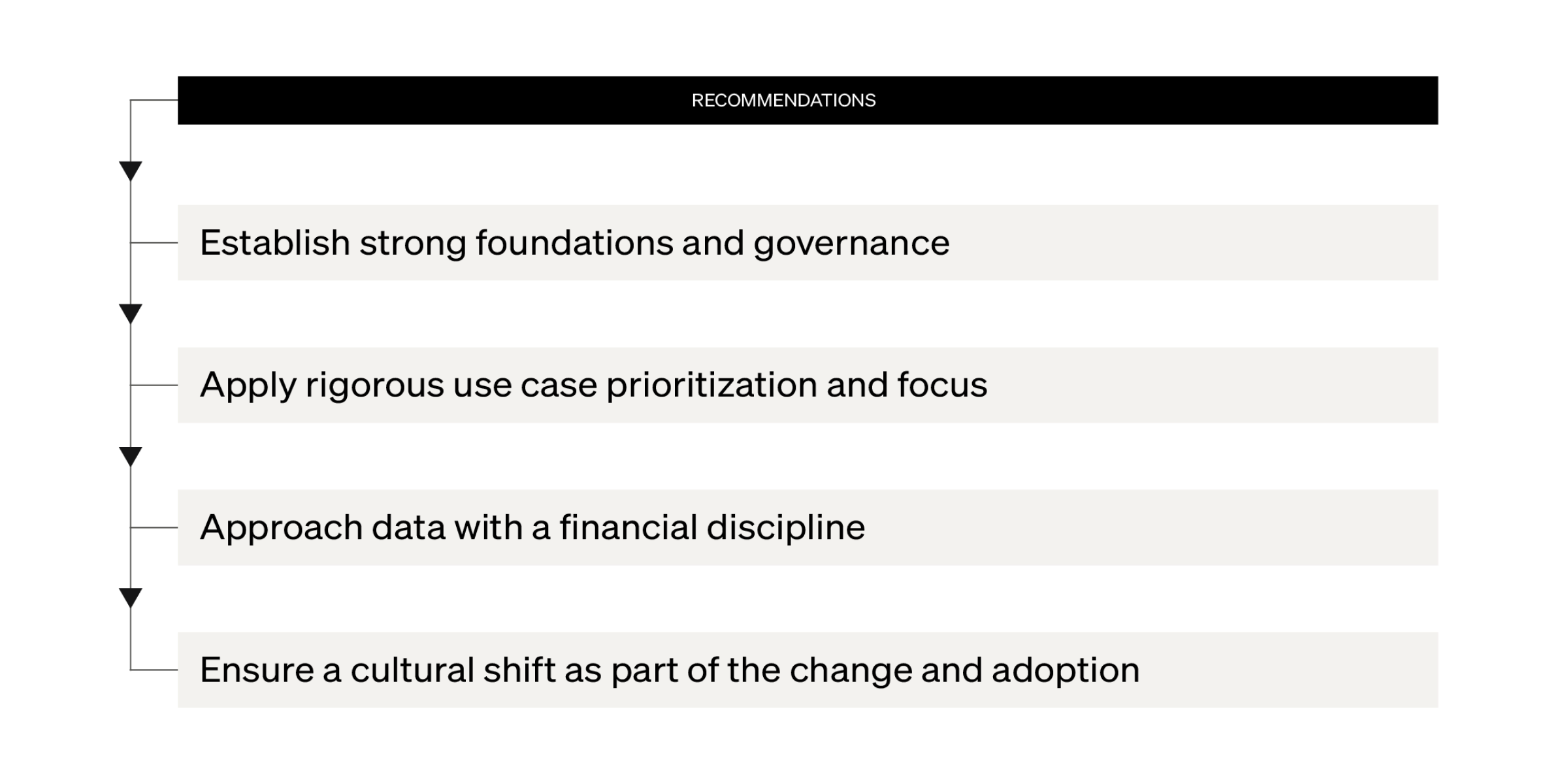
Recommendation
Recognizing and measuring the value of data is crucial for businesses. Establishing a metric like RODA can help organizations understand and leverage their data assets, ultimately positioning data as a key driver of business value on par with traditional assets.
Based on our advisory in this space and experiences in everything from data maturity to advanced analytics and AI in many complex situations, some core recommendations to clients are:
-
Establish strong foundations and governance to turn data into assets that can be used to drive revenue and profits.
-
Ruthless use case prioritization and focus (to do the right things, right — and at the right time).
-
Approach data with greater financial discipline (to get a mandate and outline the value for the full business). This is where RODA plays a crucial part, in quantifying the value of data.
-
Ensure the cultural shift along with the financial aspect to bridge and bring the business on board (for RODA to be effective, companies must ensure data is valued).
Data shouldn’t be undervalued, underutilized, and under-monetized when its potential is greater than good, we just need to show it. In a world full of equal data promotes and growing frustrations, RODA should be a guiding star to secure both short and long-term results of your initiatives, and your company’s acceptance to invest.













